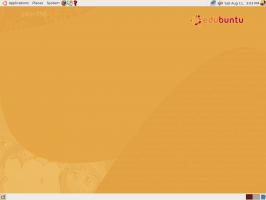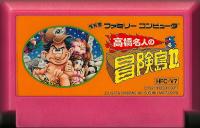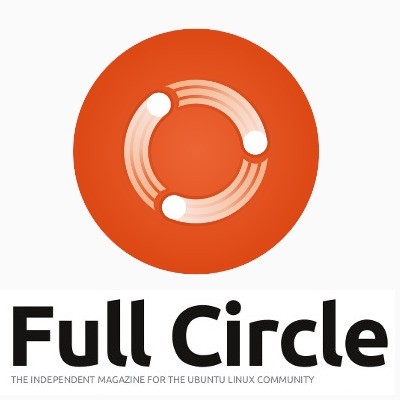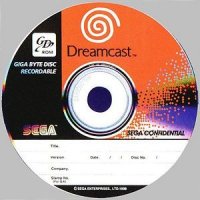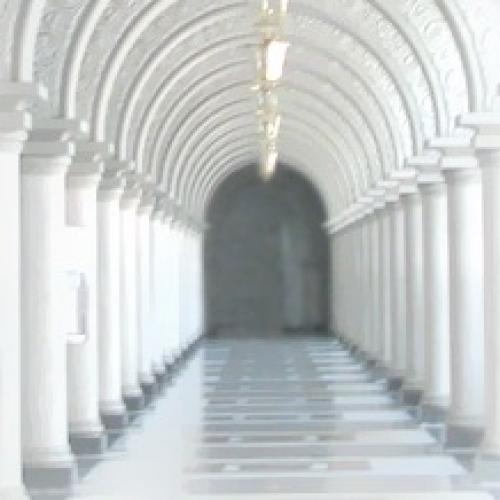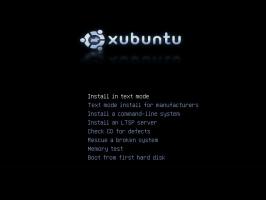How To: Edubuntu Glows, Interest Grows
On June 20 and 21 the Colorado Local Community (CoLoCo) Team manned and maintained an Ubuntu/Edubuntu booth and a three hour demo session at the Technology in Education (T.I.E.) Conference in Copper Mountain, Colorado. I had an opportunity to sit down with David Overcash and Jim Hutchinson from the team and hear about the experience first hand.

Written by Chris Rowson
To begin, T.I.E. is a Colorado-based organization founded in 1986 by a group of teachers with a vision of the important role technology would play in education. Last year's conference featured over 165 different workshops and spotlight sessions with over 140 different presenters, mostly classroom teachers.
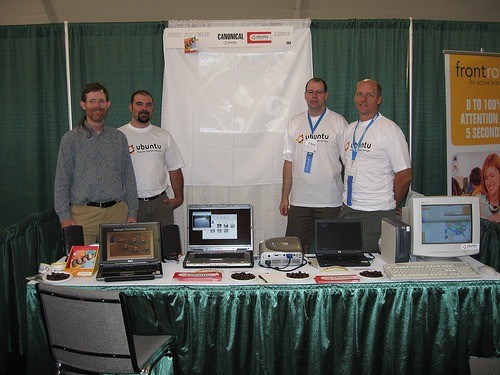
The CoLoCo team originally decided to attend and present with as little Linux introduction as possible, and to mainly focus on Open Source programs for educational gain. Instead, they decided to just go ahead and take the extra steps needed to introduce Linux as well. In the end it became a huge demonstration of the power of Edubuntu to the teachers, administrators and IT personnel that were present.
I asked about what sponsorship and support HP and Canonical lent in preparing for this conference. It was explained that Canonical provided money to host a booth at the conference and courteously provided a conference pack of CDs, stickers and pamphlets, which helped in making the presentation be more professional.
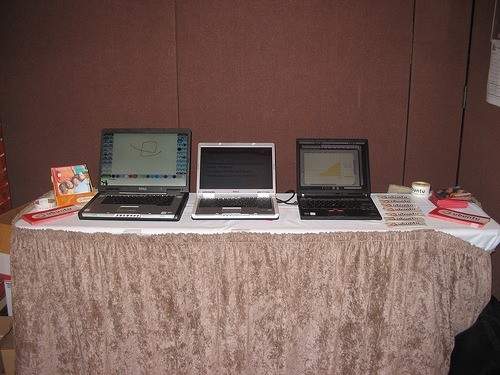
It was also explained that Bryan Gartner from HP was really only there as a volunteer, but was enthusiastic about helping out and supplying the thin-client server for the event. So, it was clear that even though HP and Canonical lent support, the big part was still up to the local team members who had committed to go.
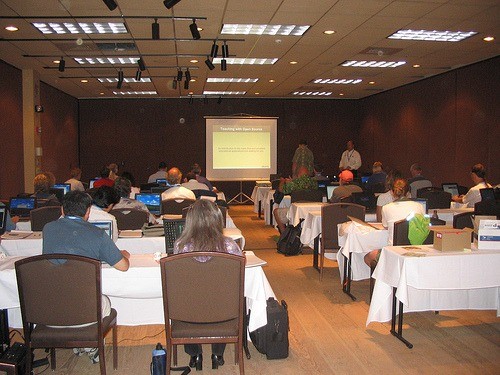
The “presentation” as I have called it, was separated into two parts. The first was a booth just outside the conference room. It consisted of some Laptops, a Desktop PC, a projector, some Edubuntu and Ubuntu CDs, Pamphlets and stickers, some daisy-chained power strips and an un-ironed table cloth.
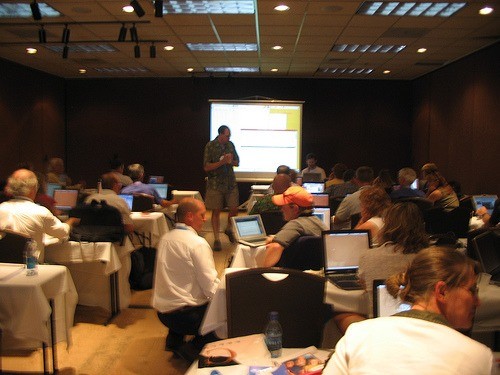
Using the team's own hardware they demonstrated the features of Ubuntu, Kubuntu and Edubuntu, passed out CDs and pamphlets and answered questions ranging from setting up thin-clients in schools to finding good educational applications. The team demonstrated various applications like Tux Paint and Stellarium, ran video clips, and showed how thin-client labs are set up.
Visitors to the booth came from all corners of education - teachers, administrators, district technology personnel - and from rural and urban districts. They mentioned that they even entertained someone from the Colorado Department of Education.
The CoLoCo members noticed near the end that at least 50 Ubuntu CDs all seemed to have “disappeared” from the booth.
The Second, or “fun part,” was the actual demo with HP's thin-client Edubuntu server. As I understand, Jim started off with a nice little introduction into the world of free and open source software and about all of the benefits available. After the FOSS intro each of the session attendants received a copy of The Open CD (http://www.theopencd.org). Jim made the comment to me that most teachers and educators are completely unaware that open source technology exists at all, and that this was his original motivation for attending. At the very least, He hoped to show teachers and educators that there are other resources out there that are cost-free!
From what I was told, several of the applications made an instant hit (especially Stellarium) and the members of CoLoCo walked around helping everyone discover the wealth of software available without licensing restrictions and available absolutely free of charge.

In addition to my “interview” with Jim and David, I also e-mailed Neal McBurnett to ask what he thought about the experience. This was his reply: “I had a blast. The most effective eye-candy to show the crowd seemed to be Stellarium. We zoomed in on Saturn and it's inner moons, and with time running fast enough that the moons could be seen to move. It's beautiful, and an educational experience for teachers that they know their students will enjoy. And it runs on multiple platforms, so it is easy to deploy."
Stellarium (above) seemed to be the most loved, but not the only one teachers enjoyed. From what I hear, one of the session attendees mentioned that he couldn't wait to install GIMP on all the computers in his labs because he didn't have to worry about licensing restrictions and no longer had to purchase copies of Adobe Photoshop!
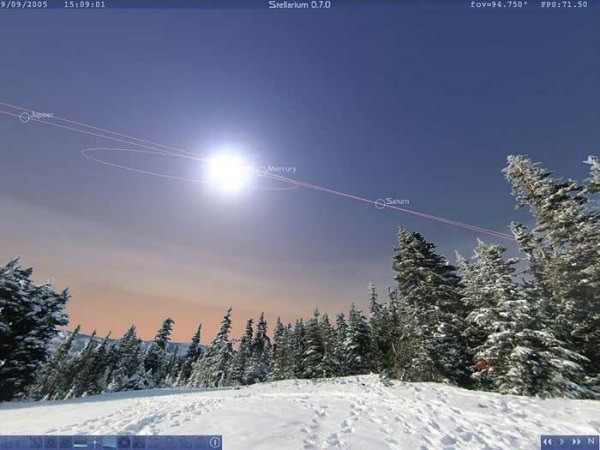
The session took a short recess. When everyone returned, they were instructed to reboot their computers and to open the boot menu so that they could select a specific boot device. While the session audience was away the quad-processor thin-client server was set up and the room was re-routed, so the network in the room ran through the server. In just 5 minutes they had transformed this windows lab into a fully functioning Linux lab by network-booting off of the thin-client server! The excitement of the room buzzed as all of the attendees couldn't wait to try out this mysterious Linux that they had heard so much about. David Overcash remarked in retrospect, “I think the most exciting part of the entire day was when the whole room suddenly had a nice warm orange "glow" coming from it from all of the Edubuntu login screens.”
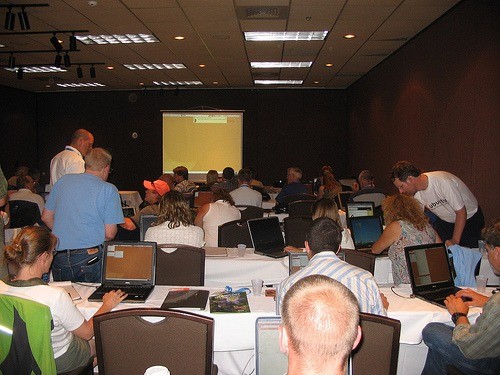
They prepared 30 logins beforehand and gave each attendant a user-name then sat back and watched as each person quickly started to explore through all of the educational applications that had been installed on the thin-client server. Jim and David told me that they were totally full, and as they were progressing many people stopped by to try to overflow the room. They told me that at least 10 people asked if they could participate with their own laptops and as the team set up extra patch cables and got them plugged into the network, they actually had to share some logins, because there were more people than anticipated! The popularity of the room was very evident to David; “We were the only session to have over 30 people that afternoon, and actually completely filled our room at around 50 participants!”
After the attendees were driven to excitement at how easy it was to use Linux, Bryan (The HP Representative) gave a quick demo of the administrator capabilities of the thin-client server. He quickly impressed his audience of system administrators with the multitude of features available for controlling program and login access on each individual machine or the entire group. The thin-client capability was demonstrated with great success during the three-hour session on using open source software in schools.
My next question was to see if there were any concerns from any of the visitors, and if so how they addressed them. The answer I received was that the main concern was that the attendees were not the people in charge, and so they couldn't get things installed or they did not know how to get something set up.
The CoLoCo team responded to the first concern by encouraging users to take the Open CD to their network administrators and find out what couldn't be installed, then install what was possible. For those needing help in getting a thin-client setup or some other area of support the team quickly collected contact information, pointed visitors to the team's website and assured everyone that if they only asked they would find members willing to come out and help. This has led to a current team project focused on developing a way to offer local support to schools, or anyone else interested in using any flavor of Ubuntu. “We not only shared great ideas, but backed it up with commitments to actually help make it happen. The true spirit of the Ubuntu community was hopefully shown in our willingness to go over the top in helping people get started using the OS,” remarked David Overcash.
After it was all finished, they distributed over fifty Ubuntu CDs and also at least fifty copies of The Open CD, not including the fifty CDs from the booth before! One hundred Ubuntu CDs in 3 hours? Not bad at all!
As the attendees were leaving some even commented “Your presentation was the 'cool session' for the afternoon!”
I asked Jim and David what surprised them the most, and they responded that it was the amazingly positive response that all of the attendees had towards Open Source software and Ubuntu GNU/Linux. They laughed and told me about one man who had a laptop (owned by his district) who was actually trying to install Edubuntu right there! They told me that he literally spent an hour or two trying to hack his BIOS (which was password protected)! Jim remarked that this was a reflection of the sad state of enthusiasm for technology in our education system; however he also noted that it was a good sign, because it shows that people really do want a change.
Overall, the booth and the 3 hour session was a great success and many people went away with new ideas and tips on how to actually make something happen in their school or district.
The CoLoCo team hopes to bring several more in-depth presentations to this conference next summer and continue to foster growth of interest and knowledge of Ubuntu for both teachers and students. The team expects to go live with local support options within just a few weeks.
For info on how to help with a similar initiative in your area please feel free to contact the CoLoCo team at any time.
Current CoLoCo projects are: Local Support Initiative, Software Freedom Day and a Gutsy Release Party
CoLoCo team website is http://www.Ubuntu-Rocks.org
You can download the presentation slides used in the demo from: http://url.fullcirclemagazine.org/44606e









